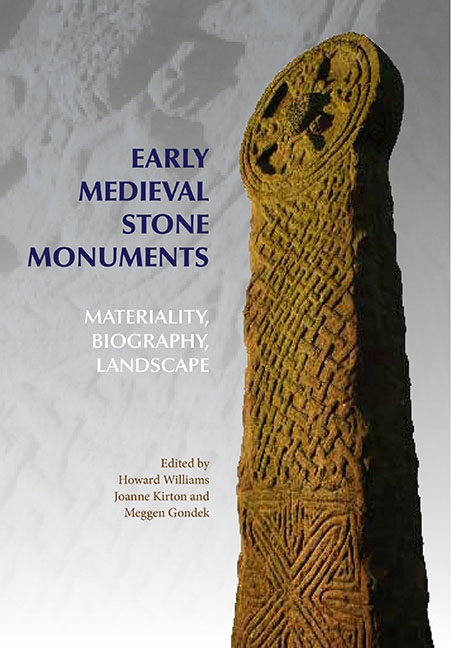Book contents
- Frontmatter
- Dedication
- Contents
- List of Illustrations
- List of Tables
- Acknowledgements
- 1 Introduction: Stones in Substance, Space and Time
- 2 Locating the Cleulow Cross: Materiality, Place and Landscape
- 3 Walking Down Memory Lane: Rune-Stones as Mnemonic Agents in the Landscapes of Late Viking-Age Scandinavia
- 4 Building Blocks: Structural Contexts and Carved Stones in Early Medieval Northern Britain
- 5 Memory, Belief and Identity: Remembering the Dead on Iniscealtra, Co. Clare
- 6 The Biographies and Audiences of Late Viking-Age and Medieval Stone Crosses and Cross-Decorated Stones in Western Norway
- 7 Lifeways in Stone: Memories and Matter-Reality in Early Medieval Sculpture from Scotland
- 8 A Stone in Time: Saving Lost Medieval Memories of Irish Stone Monuments
- 9 Hogbacks: the Materiality of Solid Spaces
- List of Contributors
- Index
4 - Building Blocks: Structural Contexts and Carved Stones in Early Medieval Northern Britain
Published online by Cambridge University Press: 21 May 2021
- Frontmatter
- Dedication
- Contents
- List of Illustrations
- List of Tables
- Acknowledgements
- 1 Introduction: Stones in Substance, Space and Time
- 2 Locating the Cleulow Cross: Materiality, Place and Landscape
- 3 Walking Down Memory Lane: Rune-Stones as Mnemonic Agents in the Landscapes of Late Viking-Age Scandinavia
- 4 Building Blocks: Structural Contexts and Carved Stones in Early Medieval Northern Britain
- 5 Memory, Belief and Identity: Remembering the Dead on Iniscealtra, Co. Clare
- 6 The Biographies and Audiences of Late Viking-Age and Medieval Stone Crosses and Cross-Decorated Stones in Western Norway
- 7 Lifeways in Stone: Memories and Matter-Reality in Early Medieval Sculpture from Scotland
- 8 A Stone in Time: Saving Lost Medieval Memories of Irish Stone Monuments
- 9 Hogbacks: the Materiality of Solid Spaces
- List of Contributors
- Index
Summary
INTRODUCTION
The Craw Stane at Rhynie (Aberdeenshire) stands in a field on a river terrace and is the only one of eight stones from the village still standing in the landscape (Fraser and Halliday 2007, 119–23). Excavation around this stone in 2011 and 2012 showed that the stone appears to be closely embedded within a probably contemporary fifth- to sixthcentury AD high-status settlement (Fig. 4.1; Gondek and Noble 2011). The site is complex, with three concentric enclosures surrounding an interior containing evidence for timber halls, imported Continental pottery (Late Roman Amphorae types 1 and 2) and activities such as fine metalworking (Noble and Gondek 2011, 319–20). Although no direct stratigraphic relationship can be established with the current setting of the Craw Stane and the features excavated on site, the entrance to the inner enclosure and at least one recut of the outer enclosure appear to respect its location. Indeed, the Craw Stane appears to stand facing an entrance that has been elaborated by a complex timber structure and a pit structure immediately adjacent. The apparent juxtaposition of early medieval buildings, probably a high-status settlement complex, and the Craw Stane challenges both our expectations as excavators and the widespread presumption that these monuments may have been landmarks discrete from habitations.
The Craw Stane is not the only carved stone to have a non-churchrelated structural context in the northern European, or even Pictish, early medieval world, but little synthesis has been done on stones in these contexts. The default assumption is that symbol stones relate to ecclesiastical and/or funerary contexts. This paper attempts to pull together the known examples of the Pictish Class I monuments with structural associations. In doing so, it aims to provide some context for Rhynie as part of ongoing work at this site, but also to use Rhynie as a point of departure for a wider exploration of the significance of monumentality, memory and art in these structural contexts as opposed to the other proposed landscape settings and burial associations often considered for Class I Pictish stones.
PICTISH STONES AND MEMORY
‘Pictish sculpture’ is a shorthand phrase to refer to those carved stone monuments dating from the fifth to the tenth century AD found predominantly in northern and eastern Scotland. This area is associated with the later Iron Age to early medieval territories and kingdoms of the Picts (Allen and Anderson 1903; Fraser 2008).
- Type
- Chapter
- Information
- Early Medieval Stone MonumentsMateriality, Biography, Landscape, pp. 87 - 113Publisher: Boydell & BrewerPrint publication year: 2015
- 3
- Cited by



